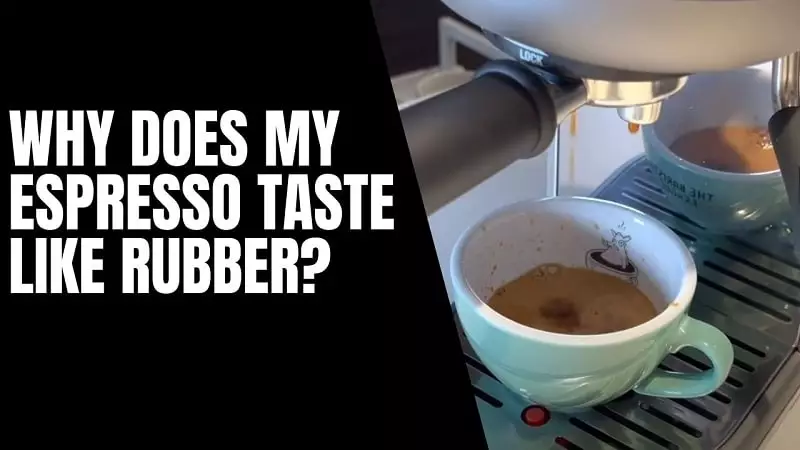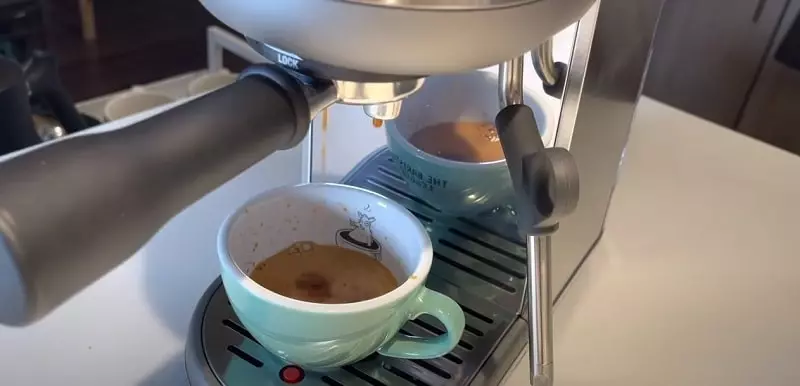You’ve probably noticed it too, but sometimes espresso has a distinct flavor that feels like rubber. And if you are like me, you must be wondering why this happens, at the very least, so we can prevent it next time.
The main reason why espresso ends up tasking like rubber is the condition of the machine used to brew it, and this happens most often when a machine is new or too old. Various factors can cause this distinct taste. Still, usually, all it takes to get rid of it is to do a thorough cleaning job.
Today we’ll take a look at all the various factors that can cause this phenomenon. I’ll try to answer your questions about espresso, and I’ll make sure to provide solutions and suggestions to avoid this. Coffee is too good to allow some foreign flavor to ruin the experience.

How can a machine affect the flavor of espresso?
Above, we discussed how the most likely culprit for that distinct flavor is the Espresso Machine that brews the coffee. But why exactly does it cause this weird flavor?
Coffee is a very complex beverage, at least when compared to things like juice or tea. And if there’s something we can all agree on, the smell of coffee is half the sale.
Coffee is just incredibly aromatic, and that distinct smell of recently poured coffee is a treat all on its own.
However, it’s important to note that the smell of coffee also becomes part of the way we experience taste. Think back to any time your nose has been completely plugged. Food tasted differently.
When we eat or drink something, we also smell it, which makes both senses integral to tasting food.
Coffee is even more aromatic than the average drink or meal, which means that it’s even easier to affect its distinct taste. Any stray odor involved in the brewing process can completely change the taste of our espresso, usually for the worst.
So if there’s an issue with your machine or any piece that has a distinct odor, this will affect your coffee tastes. But that does bring the question of why it tends to taste like rubber in specific?
So why does espresso taste like rubber specifically?
If we blame the machine for the rubbery taste, then logic dictates that the sealing elastic is at fault, right? Not necessarily, there are many parts in the extraction process that can generate this taste, and a lot of times, rubber isn’t involved.
Do you know how certain products smell new? Well, this is very often the cause of your rubbery dilemma. The first few loads of any espresso machine have a marked tendency to taste rubbery because this distinct smell is still present all over it.
New items smell like that because they haven’t been exposed to air and the elements. So this smell will eventually go on its own. And after a few days of use, your espresso shots will likely come out flawless.
If this isn’t the case, we need to go over all the parts of the machine. Of course, the rubber gasket can be the issue, and changing it is a good call if you suspect it. However, I find that the gasket is most often when a machine tends to overheat. Does your coffee often feel burnt?
If this is the case, then your machine probably reaches higher temperatures than it should. This affects the beans and can also cause the rubber to get damaged and hence release that smell.
Now let’s say that the gasket is fine, the temperature is also fine, and the machine isn’t new. In these cases, you should probably take a look at the water tank.
There’s no denying that dirt in the tank can affect the flavor of coffee, but at times the opposite is true. If you think about it, plastic and rubber come from the same source. So the tank itself can cause this unique flavor to appear.
Make sure to give a thorough wash to your tank, do it multiple times. What we want is for the tank to smell natural. Not like plastic and much less like soap. Once you have reached that neutral odor, then the taste of your coffee should be OK.
What if it isn’t your espresso machine?

So you have done a thorough job at cleaning your machine, you’ve changed and cleaned so many things it might very well be a new product. But despite your best attempts, you still get that distinct rubbery taste; why is that?
While not as common, sometimes the issue can be the coffee itself. Ruber is not a flavor we’d usually associate with coffee, but certain habits and certain beans can result in a similar flavor appearing in the brew. If this is the case, then changing some things or your brand of coffee should be enough.
How do you handle your coffee? Do you grind it ahead of time and keep it stored that way? Believe it or not, this can be the cause of your troubles. Recently ground coffee is more aromatic and, as such, packs a stronger flavor. It feels “more” like coffee.
This is because grinding causes it to release its aromatic compounds, and that’s ideal for brewing.
On the other hand, if you grind your coffee and let it sit for days or even hours, you’ll be losing many flavors. Ground coffee left in storage will lose its natural aroma and hence flavor.
When this happens, the beans can pick the container’s smell, hence the rubber taste. Alternatively, the loss of aroma can cause the blend to taste more like the bean’s natural oils, and that’s what affects the espresso.
One of the names I hear most often when people complain about a weird taste on their espresso is Robusta. A lot of people are more used to Arabica beans even if they don’t realize it.
Coffee made from Arabica beans tends to be sweeter, and it’s closer to chocolate than anything else. It tastes like coffee, but it’s overall milder.
Robusta beans, on the other hand, pack much more caffeine and is more forthy. As a result, it’s a very popular pick for espresso, but this does come with some caveats. The flavor of Robusta beans is considered to be less refined, and depending on the brand, this can be very noticeable.
Some Robusta beans can taste like burnt oil, or at least for people who aren’t used to it. Hence your espresso tasting like “rubber.”
Chances are Robusta is just not your thing, and this isn’t a bad thing. As we said, Robusta has various advantages for espresso, but the taste isn’t necessarily one of them.
How to avoid rubbery coffee on the go?
If you don’t make your coffee but rather choose to buy it. It might take some more effort to find your perfect blend.
The first thing to keep in mind is that you shouldn’t be afraid of trying out new things or asking questions. Let’s say, for example, that your favorite coffee shop used to have the perfect espresso, but recently the taste has changed for the worst. Ask them if they’ve changed their beans and if they have another option with the old beans.
There’s nothing wrong with asking around, provided you are polite, and you might even help them go back to their old and classic flavor. If they dismiss you well, then it’s less business for them.
Another good idea is to try out more coffee shops on your regular route. There’s no shortage of coffee on the streets, and the more you try, the more options you’ll have. You might just found the perfect brew if you allow yourself to be more daring.
Also, it would help if you kept in mind that flavor doesn’t necessarily have to be consistent between the same franchise.
Each shop has different machines, managers, and bean policies. So just because you disliked one Starbucks, you won’t dislike them all and vice-versa.
However, if you want to ensure the perfect taste, you’ll have to buy a machine of your own eventually. If you add the numbers in your head, you’ll realize that it saves you money in the long run, which is a great plus.
But first and foremost, it allows you to control every step of the process and make sure you can find the perfect balance for you.
The best part is that since it’s your machine and your own rules, you don’t have to worry about flavor changes.
If you find the perfect way to do espresso, you can keep repeating the same process for as long as you want. It’s honestly a great investment if you love espresso.



